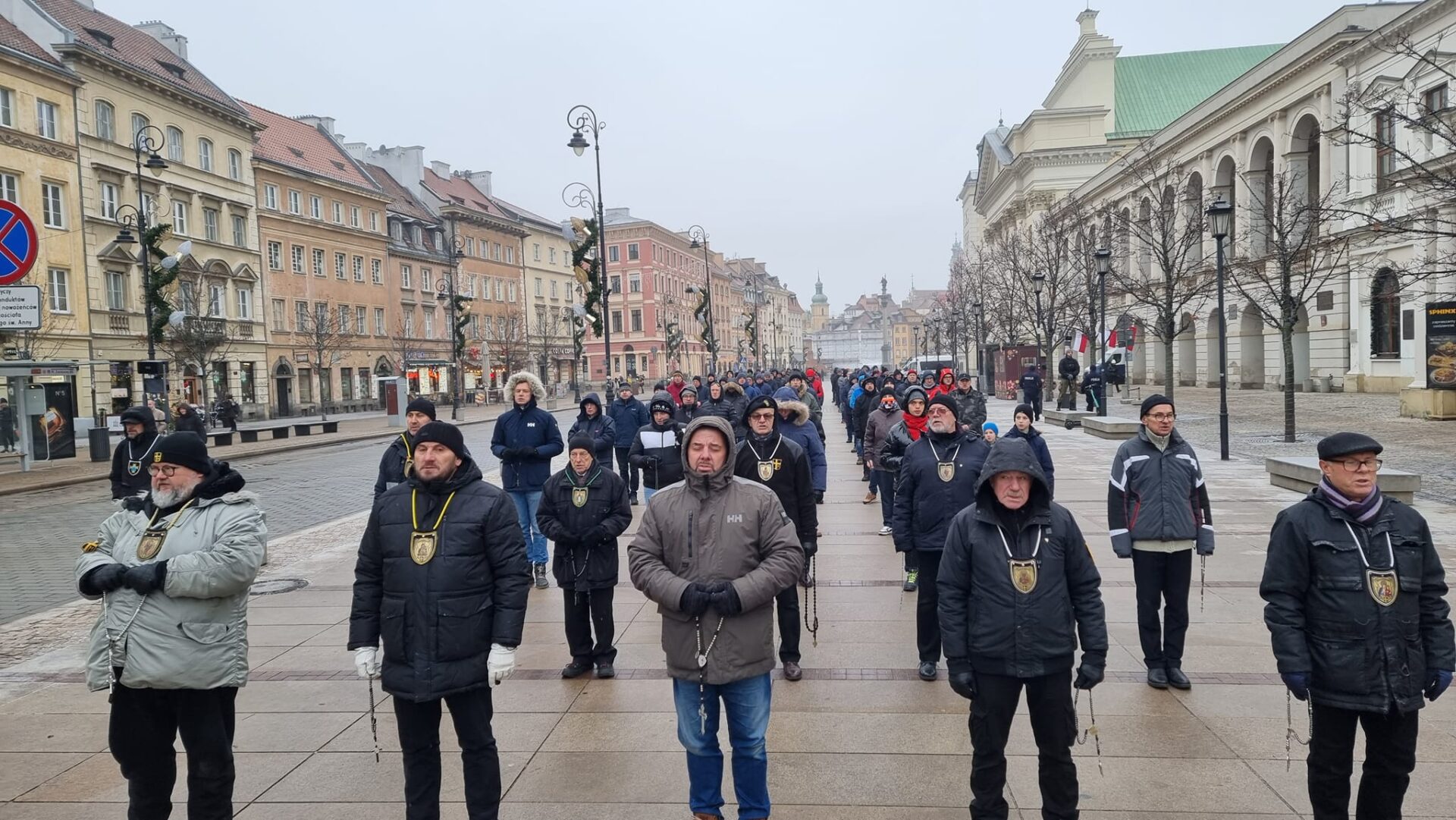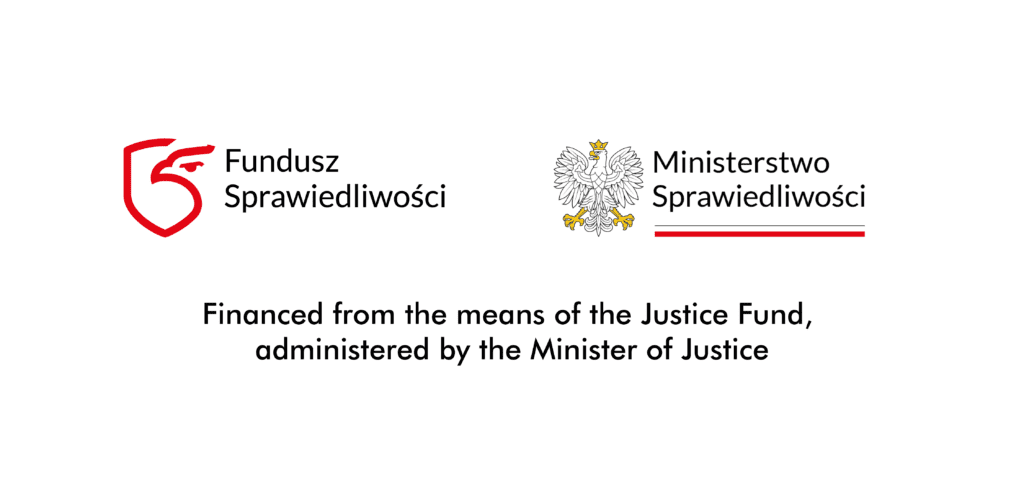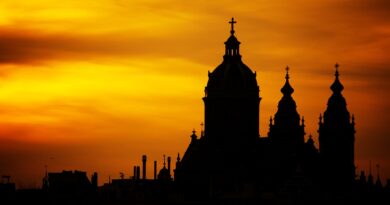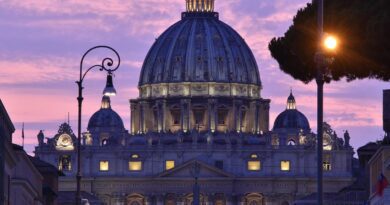Warriors of the Rosary

The vigor of Catholic devotion to the person of the Holy Virgin Mary is not declining in Poland. Ever since such seventeenth-century events as the defense of the Marian sanctuary on Jasna Góra and the Lwów Oath of King Jan Kazimierz, the worship of Mary has represented a central current of religious identity in our country.
Tomasz Rowiński
Nobody in Poland is surprised any more by media reports of groups of tens or even hundreds of men praying in the streets of Polish towns. The Men’s Rosary movement has become a part of the spiritual landscape of Polish Catholicism. Linked with the movement are other men’s religious communities well known in the country, such as the Warriors of Mary, the Soldiers of Christ, and the Men of St. Joseph. Men at prayer can be encountered in more and more towns and cities.
“You are walking through Warsaw’s Old Town. It’s a sunny Saturday morning. Suddenly quite a large group of men appears before your eyes. Some kind of procession? The army? Their numbers keep increasing. They are walking in a tight group. A really extraordinary sight. It is indeed an army – God’s army,” Jarosław Kumor wrote on the aleteia.org website in 2019. And often that really is what it looks like. Even if you have never attended such an event, or met the rosary warriors on the street, there are many photographs published online of these “prayer meetings.” They are led by priests, and alongside them, smiling well-built men – rows of smiling men. Smiling for the Holy Virgin Mary.
Who are the members of the Men’s Rosary? “We are men who desire to fulfill the will of Mary – our Mother and Queen. We wish to do exactly what she requested of all of us and continues to request. Her will is the will of her son Jesus Christ, our Lord and brother. Fulfillment of those instructions serves the greater praise of God, so that His children can be with Him for eternity. That means us, our families, and all people who desire to partake of His grace,” we read on the movement’s website.
One might say, then, that the Men’s Rosary is formed by ordinary Polish Catholics drawn by God, by Mary, by the power of prayer, but also the power of the community. “We believe that our role – the role of men – in God’s plan is to protect for eternal life all those whom God has given to us here on Earth. Just as St. Joseph was the earthly guardian of the Holy Family, so we have the task of defending the sanctity of our families and those close to us. We want to do that together, in a community of men. In this group we strengthen our male identity and male virtues,” the men write in a short manifesto describing their identity.
Where did the Men’s Rosary movement originate? Its roots go back to 2017. “The idea was to bring male groups within the Catholic Church together in common activity,” Men’s Rosary organizer Jan Sienicki said of the movement’s beginnings some years ago. “When I went on the first Men’s Siege of Jasna Góra in November 2017, I saw that there were very many such groups. I thought that this was a great strength, and in a situation where the family is often a target of attacks at the moment, we can put up resistance, we have such potential,” he added.
The Men’s Siege of Jasna Góra is an annual event organized by the community called Men of St. Joseph. That community writes of its identity in almost military terms. “Mission: For every man to discover the divine plan for his life and to live by it. Goal: The holiness of Man. Motto: Learn the divine plan for your life! Priorities: God – a personal relationship; Wife – improvement and deepening of relations; Children – a true authority; Work – for the family, joy, effectiveness; Service – support for brothers in faith.”
The Men’s Sieges combine a pilgrimage element (participants come to Poland’s most important Marian sanctuary, in Częstochowa), a prayer element (they are accompanied by priests and bishops, and take part in acts of worship to the Lord that can last for the best part of an hour), and an educational element (teaching and lectures are given by well-known authorities on Catholic life in Poland, both lay and clerical). The first Siege was attended by archbishop of Poznań Stanisław Gądecki, head of the Episcopate of Poland, as well as archbishop of Łódź Grzegorz Ryś, who was made a cardinal in 2023. The most recent Siege, in autumn 2023, was preceded by an additional series of preparatory workshops, which included theological lectures in ecclesiology (study of the Church).
Influenced by his experience attending the first Men’s Siege of Częstochowa, Jan Sienicki set up, in the Warsaw parish named for St. John Paul II, a community called Men of St. John Paul II, which gave birth to the new movement. Another impetus for the development of the Men’s Rosary was its first organizer’s encounter with another male movement, the above-mentioned Warriors of Mary.
“This newly formed community of ours was visited one day by Artur Wolski from the Tato.net initiative [a Catholic group preparing men for mature fatherhood – TR], who also chairs the Wings of Praise foundation, and who desired to see fathers taking part in common rosary prayer for their families. On the other hand, I myself, at ‘Rosary to the Borders,’ found out about the First Saturday services and the fact that the Holy Mother had deemed them salvation for the world. This was how the Men’s Rosary idea was born, under the spiritual guardianship of Father Dominik Chmielewski, leader of the Warriors of Mary community,” Jan Sienicki said in 2019.
It is worth considering for a moment one of the initiatives that Sienicki mentions. “Rosary to the Borders” was probably the most important contemporary impetus for the birth of modern rosary movements in Poland. It was organized twice, in 2017 and 2020, by two converted movie directors: Maciej Bodasiński and Lech Dokowicz. The aim of the event was to hold rosary prayers chiefly in the border regions of Poland. Participants chose one of 320 churches in border parishes and gathered there in common prayer. The organizers reported that about a million people took part.
“The rosary is a powerful weapon in the battle with evil, so strong that on more than one occasion it has been able to change the course of history, while thousands of attestations and documented miracles prove its extraordinary effectiveness. Mary is the Queen of Poland who has protected us through the generations – at critical moments in history She was always with us, and we with Her. The Holy Mother points to the rosary as salvation for the world. We thus believe that if the rosary is said by around a million Poles on the country’s borders, it might not only change the course of events, but also open up the hearts of our compatriots to the action of divine grace. Powerful rosary prayer can influence the destiny of Poland, Europe, and even the whole world. Suffice it to say that Mary makes a request for frequent rosary prayer almost every time she appears,” wrote the organizers of the event, which was reprised in 2020. On that occasion it received support from Pope Francis. Similar actions followed in numerous countries of the world, including Italy, Britain, Ireland, the United States, countries of South and Central America, and Australia.
It is worth recalling the prayer intentions formulated during the 2020 event, because they seem to reflect well the social spirit of profound Marian piety in its new forms. “We atone for all sins of abortion committed in Poland. We ask the souls in purgatory for prayer, we offer pardons. We apologize to the unborn children, we take them into our families, and ask for a prayer for us. The fruit of this great prayer made by Poles might be the restoration of hope, faith, and acceptance of the Truce of God,” the organizers wrote at the second edition of the rosary event.
An important and perhaps the best known of the new men’s Catholic communities in Poland is the aforementioned Warriors of Mary, founded by the Salesian Father Dominik Chmielewski. That group is also significant in that Father Chmielewski, as Jan Sienicki noted, is the spiritual guardian of the Men’s Rosary movement. Father Chmielewski also promotes the rosary in his own community. Primary among the spiritual training tasks of a Warrior of Mary is the completion of a daily rosary prayer, namely fifty Hail Marys, divided into five decades, during which thought is turned to events from the life of Christ and of the Blessed Virgin Mary.
Father Chmielewski said in March 2023, when asked by the Polish Press Agency why male communities choose such a public form of prayer: “Faith was never a private matter. Jesus taught publicly, prayed in public places, died in a public place, and so manifestation of one’s faith and evangelization in public places are written in the DNA of Christianity. Sometimes when we pray we do it publicly, saying the rosary in towns across Poland, to entrust to God all of the people who live there.”
In an article on the Men’s Rosary published on aleteia.org, Jarosław Kumor writes that one of the movement’s goals is to free men from the conviction that public expression of faith is no longer possible in today’s world, that religious matters have been locked away in private space. Another phenomenon is worth noting: while the Church today is a place where women still feel at home, the place of lay men is hard to define. The men’s communities fill that gap to a certain degree. The fact that practically the whole of the new male religious movement in Poland is attacked by the liberal media – sometimes mocked, sometimes presented as a threat, whether to the values of “modern society” or even to the Church itself – shows how successful the initiative has been.
Of course, we may ask whether this new men’s piety movement, in some sense a revival of the once very popular Knights of the Immaculata founded by St. Maksymilian Kolbe (although there is no historical connection), is not somewhat anachronistic in its form. Whether the fact that these brotherhoods are not more strongly rooted in the beauty of the older Catholic ritual, and sometimes even the coarse visual impression they make, perhaps help religious skeptics to undermine the reality of their spiritual experience and message. One might also consider, based on the history of Christianity, whether a renewal of piety should perhaps entail taking up some kind of mission in earthly life. Since men’s rosary prayer is performed as a public event, maybe it is a sign of providence that the fruits of that prayer should also be public? Maybe the men seeking their spiritual path through the arms of Mary should acknowledge such public tasks?
In spite of certain doubts, it is unquestionable that the vigor of Catholic devotion to the person of the Holy Virgin Mary is not declining. Ever since such seventeenth-century events as the defense of the Marian sanctuary on Jasna Góra and the Lwów Oath of Poland’s King Jan Kazimierz, the worship of Mary has represented a central current of religious identity in our country. In the times of the partitions, from the end of the eighteenth century through the whole of the nineteenth, ordinary people as well as nobles and intellectuals made pilgrimages to the image of the Holy Mother of Częstochowa carrying rosaries in their hands. There was always a rosary in the hands of the blessed cardinal Stefan Wyszyński and St. John Paul II. Mary was so significant to Poland and the Poles that when the millennium of the baptism of Poland was celebrated in 1966, the communists who then ruled Poland even arrested the picture of the Black Madonna of Częstochowa that was making a tour of Polish parishes.
In recent years, when processes of secularization have been visible in Poland as elsewhere, one might have thought that the Poles’ yearning for the Mother of God would become a thing of the past. That did not happen, however: her presence has emerged anew like a sacred spring. Mary has again found her people, as usual away from the main routes trodden by the rich and powerful – somewhere among ordinary men she has found her witnesses and devotees to bring the message of peace to the world, because without repentance there will never be peace. Therefore we say: Ave Maria!




